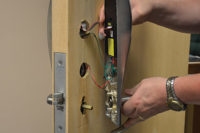In a perfect world every access control system would talk to every video system and form a well-balanced duo capable of branching out into further integrations. Today there are many options that offer a workable approximation of this. However, all too often a typical integration project goes more like this:
“We just completed a hospital designed and engineered on the East Coast,” says integrator Skip Sampson, president, Koorsen Security Technology, Indianapolis. “Access control was specified by one manufacturer. The video management system was a separate company, and the cameras were two other different companies. There were four manufacturers involved between access and video. It was very painful for us as the guy in the middle. Fortunately it was a big enough job that we were able to get the manufacturers’ attention because the things they said would integrate when this began in 2012 didn’t necessarily work in 2014. It is a constantly changing environment.”
For most integrators, opportunities to start integration projects from scratch are few and far between. It is far more common to have to work with one (or more) existing systems on either or both the access control and video side.
“I have seen customers with four different access control systems and three video systems,” says Jimmy Palatsoukas, senior manager of product marketing, Genetec, Montreal, Quebec.
Still, integration between video and access control remains not only the most popular combination but is more common than ever before as more end users request — and expect — it in their systems.
“I would say about 90 percent of our new installations include some sort of integration to the video,” says Barry Lees, director of special systems group, Xzact Technology, Charlotte, N.C. “That is up 100 percent from a couple of years ago.”
One of the driving forces for integration has been the proliferation of video technology over the past several years.
“The video folks have been far more progressive in their partner programs,” Chris Sincock, vice president, security business, DAQ Electronics LLC, Piscataway, N.J. “The explosion of digital video has been phenomenal. I think the video companies have realized that a good way for them to differentiate themselves is to make sure they have as many integration partners as possible.” Standards such as ONVIF have also helped propel video standardization, giving end users more choices of cameras and NVRs within a project.
On the access side, things haven’t moved as quickly in the direction of openness, and the complexities are different. Most manufacturers offer integrations with a variety of video and other security components: but not often with their fellow access control competitors.
Another variable is the definition of ‘integration’ itself. Is it allowing the access control system to tag events using a camera, or something more in depth?
“Customers are interested in making it as simple as possible,” says John Krumme, CPP, president, Cam-Dex Corporation, Kansas City, Kan. “A lot of security directors want one icon and video and access control with mass notification. It becomes the platform for a number of devices. But it is on us to make all of that work and trying to get the integration worked out with that ‘foreign’ vendor.”
Meeting customer expectations is half the battle, Sampson says. “Our customers are probably more educated than ever before and they read about features of a particular camera or VMS system. When we say we are going to integrate they truly expect to have all the feature sets of both products. But the definition of integration allows you to get away with passing video and calling it integrated. That is a long way from the feature sets of both products.”
What often happens instead is that one user interface sits “on top” of the other and the end user then will open the other interface as necessary for more functionality.
Integration Approaches
For years, the most common integration method has been for one manufacturer to get another’s application programming interface (API) or software development kit (SDK) and make the two systems talk.
“If you are a manufacturer that has a partner program, the more robust the API is, the more functionality the manufacturer allows you to access, the better the integration will be,” Sincock says.
An increasingly preferred method is to go with manufacturers that either have a unified platform (manufacture both elements specifically to work together) or a native integration – often larger manufactures with both video and access control divisions.
“Some manufacturers have integrated systems where they have the access and video as part of their own package and that certainly works better than introducing a third party to it,” says integrator David Alessandrini, vice president, Pasek Corp., Boston.
“It can cost a lot of time, money and energy to make these two systems work together so often our safest way to go is a manufacturer that offers both,” Sampson says. “That works 99 percent of the time.”
It also offers the benefit of a simple platform. “The whole world just gets a lot cleaner and integrators want to be able to approach the customer with a way to do a significant number of things with as few tools as possible,” says Joshua Phillips, director of product marketing, Verint Systems Inc., Melville, N.Y.
They also want to be able to offer the ability to use “best of breed” products that may not be the ones natively integrated or unified within the platform.
“We have a product that does unified access and video,” Palatsoukas says. “However, at the end of the day it boils down to the customer needs. When you are going into a green field situation with a brand new product and you can pitch a unified system with a single software platform the message goes over very well. But in a scenario where a customer already has a significant investment we will work with third-party manufacturers.”
Honeywell takes a similar stance with their products, says Chris Koetsier, director of product marketing, Honeywell Security, Melville, N.Y. “We have two primary suites that both integrate tightly with our video management system, which in turn also integrates into both Honeywell and third-party video systems. Customers are not restricted exclusively to Honeywell. There are 18 existing ones and we can do others as the business case requires.”
The advantage to unified or tightly integrated systems under one manufacturer are that they integrate at the code or even driver level and circumvent some of the problems with updates, software changes and feature compromises that other methods might encounter.
“Software continually changes,” Koetsier says. “The way we handle that today is we maintain a sustained and very tightly integrated driver-based partnership. Before we release and update, we ensure the integration remains whole. If a third-party system changes, very often it won’t affect anything because it is not at the code level or it is a matter of a simple no-cost driver upload.”
Open systems or standardization across platforms is another popular approach, particularly where a simpler integration is all that is wanted or needed.
“We use a universal DVR viewer and exchange information with a wide number of video platforms says Gary Staley, national sales director and founding partner, RS2 Technologies, Munster, Ind. “It is a very simplistic manager. We don’t go so in depth with the integration but when an alarm happens or a door is forced open we can associate the nearest camera to that. I don’t see any need for deeper integration in most cases. If we were to get in deeper with one manufacturer that would take away our flexibility with the others.”
“On the access control side, Mercury panels have been functioning as a De Facto ‘open standard’ for several years,” says Steve Lucas, director of business development, Mercury Security, Long Beach, Calif. “We have 20-plus business partners so the end customer has choices. I am a big fan of open standards, but I understand why we still have to rely on APIs in many areas. Open standards can’t always do everything.”
As far as integration between access and video has come, there is still quite a ways to go. Most manufacturers and integrators see this as a long-term development with no one solution. One thing most agree on is that the continued emergence of standards will be a necessary step and one that is still in its beginning stages. However, the role of the integrator will always involve some complexities. n
About Standards
Almost all integrators and manufacturers agree that standards are and will continue to be a good thing for the industry. When it comes to integration between access control and video, two of the main standards bodies are ONVIF and PSIA (Physical Security Interoperability Alliance). Read more on how these standards are impacting the integration of video and access in “Standards’ Role in Video, Access Integration” at www.sdmmag.com/standards-role.
Pain Points
With all the options and capabilities and features available today to integrate access control and video, integrators and end users have more choices than ever before. But that doesn’t mean they are satisfied. What do integrators truly think of integration today?
“I would rate the current state as ‘fair,’ not great by any means,” says John Krumme, Cam-Dex Corporation. “In reality there are still a lot of manufacturers that strictly want to stay only with their products, particularly if they have both access and video. They may advertise that they integrate to a foreign product, but that is usually pretty shallow. There are some that do it better than others and some that have no interest in integrating at all.”
Skip Sampson, Koorsen Security Technology, often finds it difficult to combine access and video from two different manufacturers, which he says his company is “forced to do quite often.”
“The pain point for the integrator is the manufacturers will say they have the integration but when you really drill down, it is not total integration,” he says. “They might pass video but not do motion detection, or maybe the whole feature set doesn’t pass through the integration. Often we find this out in the field.”
With the popularity of integration, most integrators at least agree there is no problem getting sales. The issues are in the implementation.
“From our perspective we tend to stay with the products we are comfortable with and that have a track record when integration is being discussed,” Krumme says. “When integration works it is a very good thing and the customer is happy. It is good for our business. We try new things very carefully and when we do we are up front with the customer that they are a test case.”






